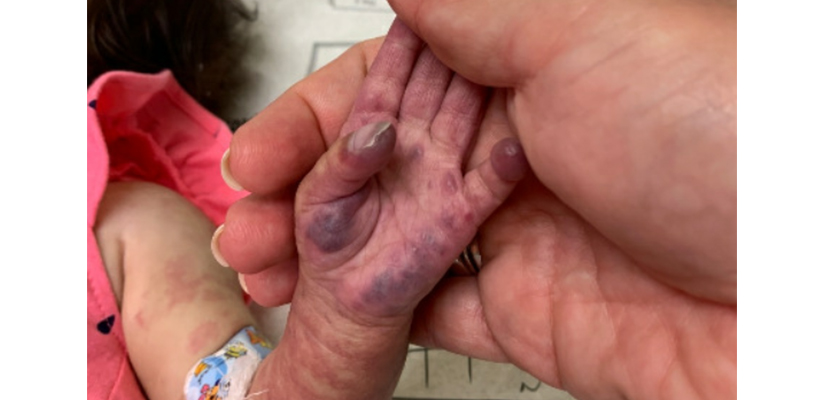Case Study: Kimberly Femat
Kimberly Femat:
Infantile Hemangioma
In early 2020, Kimberly Femat saw Le Bonheur Chief of Pediatric Dermatology Teresa Wright, MD, to examine a vascular birthmark on her left arm and chest. The mark was not causing any issues for Kimberly, so Wright decided to wait and see how it progressed before any kind of treatment.
“Vascular anomalies can take time to develop, so it was hard to determine exactly what was going on,” said Wright. “To predict how it will behave, we need to know what it is. With time and follow-up, we could properly diagnose and then treat Kimberly.

The COVID-19 pandemic broke out just weeks later, and Wright did not see Kimberly again until she presented in Le Bonheur’s Emergency Department in significantly worse condition. She now had swelling and a lesion in her upper chest and was severely anemic. The anemia indicated that Kimberly was bleeding internally, but it wasn’t clear where. The Vascular Anomalies team needed to determine exactly where and why she was bleeding and diagnose the lesion in her chest as quickly as possible.
“When Kimberly presented with anemia, it became clear that it was because of blood loss,” said Cliff Takemoto, MD, a hematologist in Le Bonheur’s Vascular Anomalies Program. “We went through the question of if the chest mass was associated with her blood loss, but it didn’t fit with a typical vascular tumor.”

After a blood transfusion, Kimberly underwent myriad tests to find the root of the problem. A biopsy confirmed that the chest lesion was an infantile hemangioma. An MRI and ultrasound of her abdomen showed that her small intestines were thickened, but an upper and lower endoscopy didn’t reveal anything out of the ordinary — a puzzling result for the Vascular Anomalies team.
Still hunting for the source of Kimberly’s internal bleeding, Le Bonheur Pediatric Surgeon Regan Williams, MD, conducted a diagnostic laparoscopy while gastroenterologists performed a push endoscopy. In this procedure, Williams and the gastroenterologists work in tandem. While
gastroenterologists could see the inside of Kimberly’s small intestines, Williams could see the outside of them simultaneously. As a result, Williams found something she had never seen before — Kimberly’s mesentery, the blood supply to the intestines, was covered in red lesions.
A biopsy confirmed this was a very rare presentation of infantile hemangioma. Because the hemangioma was covering her mesentery, the lesions could not be surgically removed, so physicians started her on the medication propranolol and steroids. Kimberly did have recurrence of bleeding and required another transfusion. Over time, the team was able to take her off steroids, and she has now been stable for a long time.
“Hemangiomas on the skin typically go away within the first 4 to 5 years of life, but internal hemangiomas like Kimberly’s can be more stubborn and take longer to go away,” said Wright. “Kimberly’s condition was complicated and confusing, but I love that my job has a challenge and a mystery. It’s a privilege to see patients like her thrive over time.”
Le Bonheur’s multidisciplinary model was especially crucial for Kimberly’s care. She had lesions on the skin, which Wright could treat, but also lesions in the abdomen and anemia on top of that, which required coordination from Williams, Takemoto and additional specialists on the team.
“In the old context, Kimberly would have been sent to me for biopsy, then back to Dr. Wright and then again to Dr. Takemoto for her anemia. None of us would have been in the same room to collaborate simultaneously on patients,” said Williams.
Now Kimberly is 3 years old and seen every two or three months for checkups at the Vascular Anomalies Clinic because internal infantile hemangiomas can have recurrences. However, her physicians are hopeful that the hemangiomas will disappear as she grows.
Help us provide the best care for kids.
Le Bonheur Children's Hospital depends on the generosity of friends like you to help us serve 250,000 children each year, regardless of their family’s ability to pay. Every gift helps us improve the lives of children.
Donate Now


















